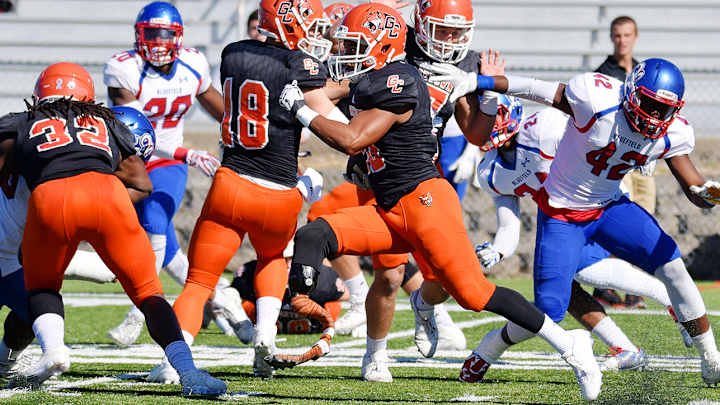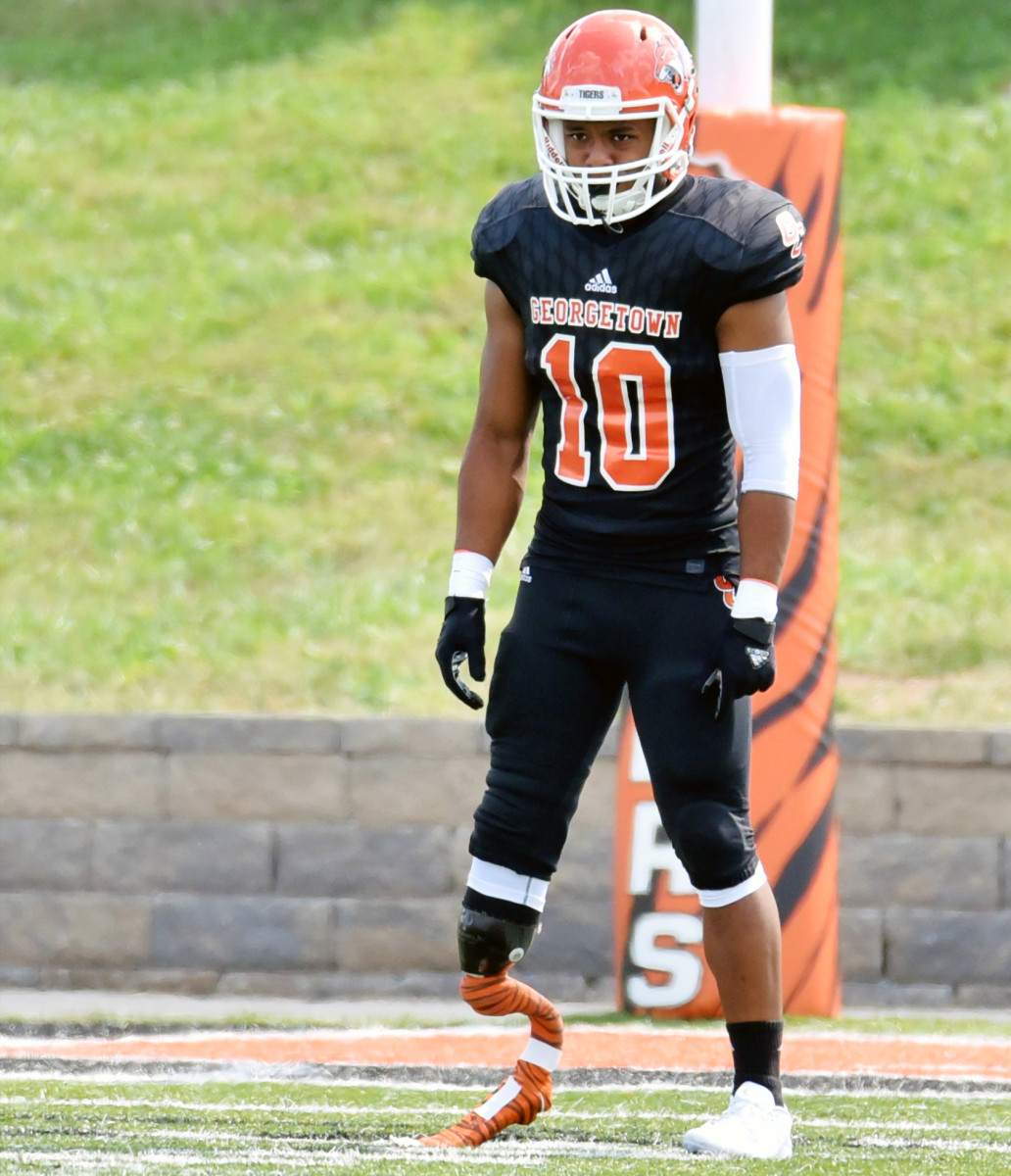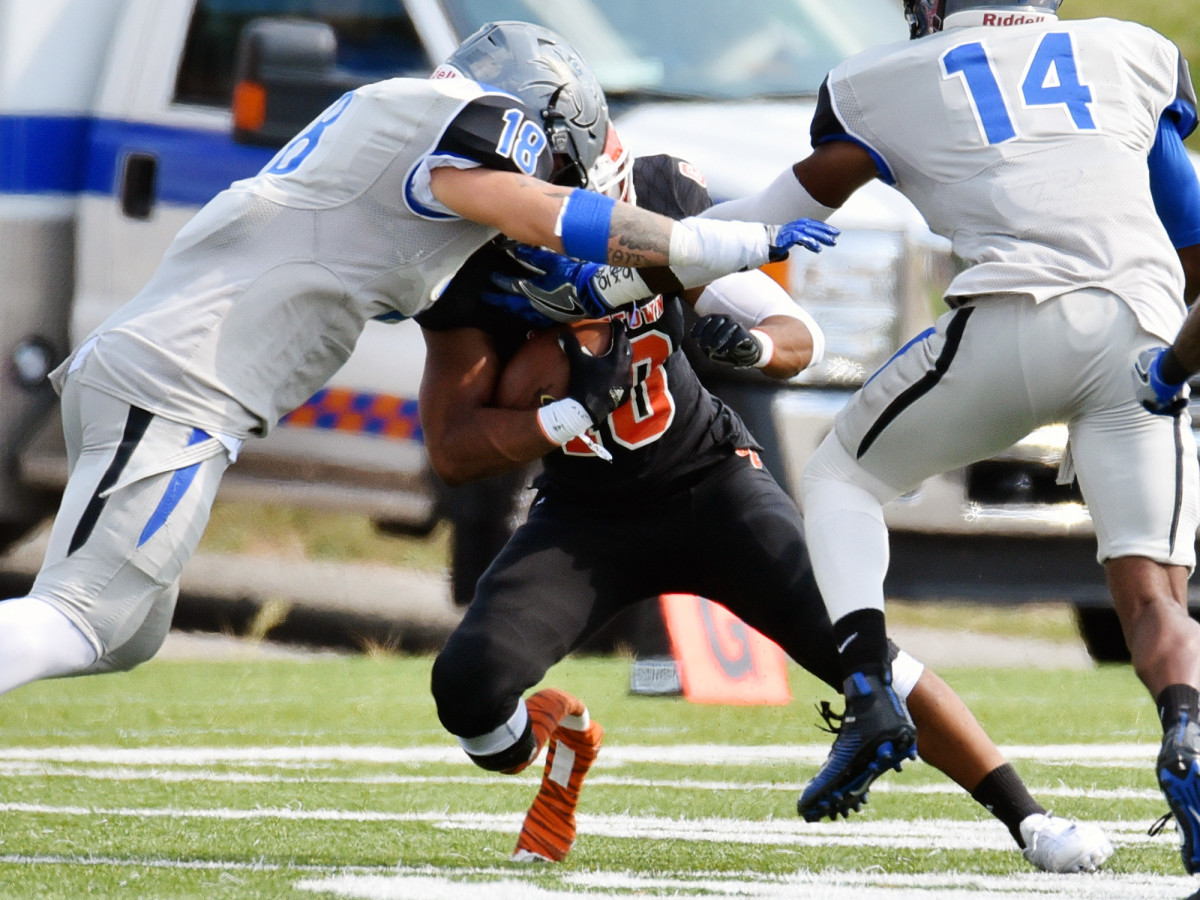Running one back: Kody Kasey perseveres through leg amputation to return to football

In the fall of 2015, Kody Kasey faced an unenviable dilemma. Kasey, then a junior at Georgetown College in Kentucky, had spent the previous year recovering from a gruesome injury he sustained on the football field. His right leg had never quite healed after he broke it while blocking on a punt return. Instead, infection had ravaged the defensive back’s leg. Doctors had inserted a rod into the leg after the initial injury but had since replaced it with more rods than Kasey says he can remember.
Now the young football player faced a choice: He could continue to have surgeries and resign himself to a dead leg and a future likely devoid of not only football but physical activity in general. Or he could take a chance and have his leg amputated.
Kasey chose amputation.
The decision prompted an uphill battle back onto the gridiron, one that culminated this past fall with Kasey returning kicks on a blade-style synthetic right leg. Inspired by Montana State’s Koni Dole, who also returned to the sport after a leg amputation, Kasey has joined a miniscule group to play college football on a prosthetic leg.
And he’s not finished yet. As Georgetown grinds through spring practice, Kasey preps for his final year of college football and the end of his dramatic football odyssey. He expresses few complaints about his situation. Not about the long hours in the hospital. Not about the surgeries. Not about the time missed nor the difficulty of playing on carbon fiber in place of bone and flesh.
“I’m just blessed. I’m still walking, I’m still running, I’m still lifting. Just the things I used to do before that maybe I took for granted,” Kasey says. “Still playing football right now, too.”
The fixer: New OC Matt Canada sets out to rewire LSU's stagnant offense
Kasey grew up in the football-mad Columbus, Ohio, area and started playing the sport in fifth grade, winning a championship his first year on a youth team stacked with talents like future Michigan lineman Taco Charlton and Northwestern defensive back Godwin Igwebuike. He met another future Big Ten star, Michigan’s Jake Butt, in kindergarten. Butt remembered Kasey as a generous friend. “One of the nicest kids I know,” Butt says. “Always put everybody else before himself.”
Kasey, Igwebuike and Butt went on to play their high school football at Pickerington High School North in Ohio. All the talent at Pickerington North brought college coaches seeking recruits, with most focusing on Igwebuike and Butt, Kasey says. But one coach from a smaller school set his sights on Kasey: Georgetown defensive coordinator Shan Housekeeper.
“From the very beginning conversation I had with [Kasey] in the coaches’ offices area, I really thought there was something pretty special about the kid,” Housekeeper says. “From that point forward, my objective was just get him on campus.”
Housekeeper did just that. Kasey says he wanted to find a school where his parents would not have to pay too much money and a football program with a winning culture. Georgetown, an NAIA program, finished 10–1 the season before Kasey arrived. It seemed like a good fit. He officially committed to the Tigers on National Signing Day 2013, joining his friends as they signed with their Division I programs.
When Kasey arrived at school in Kentucky, Housekeeper says the freshman immediately made an impression. In camp, Kasey’s speed shocked Housekeeper. “Some of the fastest feet I’ve ever seen,” Housekeeper says, with “strength on top of that.”
Kasey says he entered his freshman year with the simple goal to earn some playing time. He blew past that goal. By October, he captured a starting role, and by November, he earned second-team all-conference honors in the Mid-South Conference. Kasey says the immediate success surprised even him.
Breaking down the NCAA's new recruiting rules
His sophomore season got off to a rougher start. He pulled his right hamstring the summer before the season, and the injury kept him out of camp and limited his ability to play early in the fall, he says.
But by the homecoming game on Oct. 18, 2014, a date he says is now etched in his memory, things finally seemed to be looking up. Kasey entered the game with just a “good feeling,” he remembered. He had friends and family in town, and his tweaked hamstring finally felt healthy. What’s more, the Tigers faced the University of the Cumberlands, the school Kasey earned his first career start against as a freshman almost exactly one year earlier.
But on a routine punt return, Kasey got hit from the side. Everything slowed down “like I was dodging some bullets in the Matrix,” he says. Immediately, he knew something was wrong. “I looked down at my leg, and I could see that it was broke. The bone was bulging.” He remembers screaming in pain as the trainers raced to meet him on the field. Kasey left on a stretcher and was rushed to a hospital where surgeons inserted a rod into his leg.
He recalls thinking at the time, “I’ll have the surgery, and then it’ll heal up, and I’ll get back on the field next year.” It would not prove that easy.
After the initial surgery on his broken tibia and fibula, Kasey says things seemed to be going O.K., and he slowly started to walk again. But at a checkup six months after the injury, doctors informed him that his bones weren’t healing. A series of surgeries followed.
Kasey says his faith in God is immensely important to him, and it helped him through the period as he approached the decision about his leg. He kept going back to Romans 12:12: Be joyful in hope, patient in affliction, faithful in prayer.
Housekeeper found out about Kasey’s decision to have his leg amputated the week of the Tigers’ 2015 game with the University of the Cumberlands, the opponent in Kasey’s first start and his fateful injury. (“Kind of an interesting way that the schedule fell,” Housekeeper says.) The week of the amputation was “about the only time” the coach ever heard Kasey sound down throughout the whole process with his leg, he says. “His attitude is such a positive mindset,” Housekeeper says. “That’s just his natural gift.”

That November, Kasey had the leg amputated just below the knee, and after a couple of months on crutches, he got his prosthetic leg. He wears one for everyday use and the bouncier blade for running. Dustin Haraway, Kasey’s roommate and a junior linebacker on Georgetown, says most around the program had assumed that Kasey would come back to the team in some other capacity, perhaps as a student-assistant coach. But Kasey had different plans. “He was so determined,” Haraway says. “Once he got his blade, he really took off in his training.”
At first, Kasey found it difficult to balance on the blade, but Haraway says it took him just three weeks before he jogged for the first time. From the moment Kasey first ran, Haraway says his friend wanted to get back onto the football field.
Kasey says he can’t stand still on the blade because it is so springy. Getting in and out of cuts also continues to challenge him. Nonetheless, he says he never thought about quitting through the whole process. He credits support from his teammates, who he says refused to give up on him.
Haraway notes the inspiration is mutual. “Throughout the whole process [Kasey] just had so much joy. I know it all goes back to his faith in God,” Haraway says. “I’ve never once seen him depressed.” Haraway’s brother, Dylan, a rising senior defensive back for Georgetown who lived with Kasey last year, echoes the sentiment: “When people see him out on the field playing, they ask themselves, ‘What’s my excuse?’” Dylan Haraway says. “He just wants to inspire others.”
Could USF make the playoff with an undefeated record this season? #DearAndy
This past September, less than nine months after he first used his prosthetic leg, Kasey returned to the field in a Georgetown uniform against Cincinnati Christian. A week later, playing as a kick returner, a position that does not force him to go backward on his blade, Kasey returned his first kick for 19 yards against Faulkner. The experience, he says, filled him with “overwhelming joy.”
Kasey progressed with each week. Occasionally, he appeared in the defensive backfield (he nabbed a single tackle), but mostly he appeared on kickoffs. For the season, he returned four kicks for 98 yards. Against Bluefield, he took one for 41 yards and says he thought for a moment he might go all the way.
“It was very special,” says Kody’s father, Michael Kasey, of watching his son play in the fall. Michael Kasey says seeing others draw inspiration from Kody proved particularly special, like when the parents of a child with a prosthetic leg brought their son to a Georgetown game to see Kody and talk to him. “That was something to see,” Michael Kasey says.

In spring ball now, Dustin Haraway says Kody Kasey appears more comfortable on his blade than he did in the fall; his speed never left him, but his ability to make cuts continues to improve. Kasey will return for one final season, and Haraway says he believes his teammate will get back to the point where he can make plays again in the defensive backfield. Bill Cronin, the head coach at Georgetown, says Kasey had a strong spring practice, noting that he’s made significant progress in terms of conditioning and agility.
Off the field, Kasey says he is interning with the Georgetown police department and will intern with the U.S. Marshals in Columbus over the summer. The internships line up with his area of study at school, criminal justice. He expects to graduate in December.
For now, he maintains his focus on football and sharing his story. Touching people, he says, is the biggest joy of all. Football may have robbed him of his right leg and temporarily derailed a promising college career, but Kasey chooses to focus on the benefits his journey has brought and the continued opportunity to play the game he loves.
“It’s a little more difficult than most people, of course, but that’s not holding me back,” Kasey says. “I’m not going to throw this opportunity away.”
